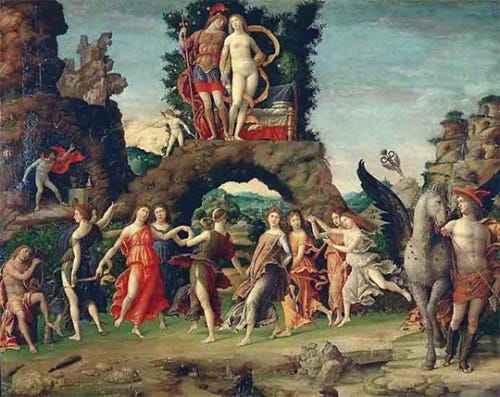The Muses: a Primer ⛲️
the keys to creative divinity

My obsession with the muses started early. Like many fated connections, I can’t point to a specific instance when they entered my life but they seem to have always been there, a favored obsession always gesturing towards more than they initially revealed.
It wasn’t until I started studying astrology, however, I found a way to dive deeper. You see, there is very little information on the Muses beyond their lineage and assigned art. Once I found out about the asteroids named after each of them, however, I knew these deities held a key to our creative practice and can help shape our artistic activities.
This post is the first in a series on the Nine Muses, pulling together years of research, study, ritual and divine interface. Keep your eyes peeled because later in the week, I will be open beta readings for these asteroids and understanding your creative practice.
Let this text serve as a foundation for your understanding of the muses as I delve into each one individually in the coming weeks.
First off, basic definitions: the Muses are the Greek goddesses of inspiration and creativity. Zeus, according to Hesiod visited the titan Mnemosyne (meaning “memory”) nine nights in a row and from those separate trysts came the Nine Muses. They were said to be born in Pieria, at the foot of Mount Olympus, and reside at Mount Helicon, where springs sacred to them existed.
Helicon is located in Boeotia, the area where the idea that there are nine of them originated. Two sacred springs existed near Mount Helicon: Aganippe and Hippocrene, both of which were reported to give poetic inspiration. Generally, springs were seen as places to go to worship them.
Each of the nine rules a certain form of art:
Calliope: epic poetry and eloquence
Urania: the heavens, astronomy
Klio: History
Euterpe: lyric poetry
Polyhymnia: religious poetry, meditation, sometimes agriculture
Erato: erotic/love poetry
Terpsichore: dance
Thalia: comedy, bucolic poetry
Melpomene: tragedy
In Archaic Greece, there were only three of them: Aoide (voice and song), Melete (thought and meditation) and Mneme (memory). These three proto-muses point to three pillars of art: the ability to recall and draw from past events ; the power of contemplating and cultivating an open mind; the skill of communicating these inner insights to others in one’s unique style.
Keep reading with a 7-day free trial
Subscribe to Recent Bedroom to keep reading this post and get 7 days of free access to the full post archives.


